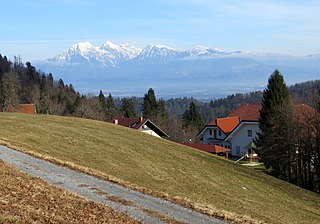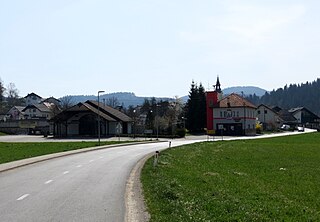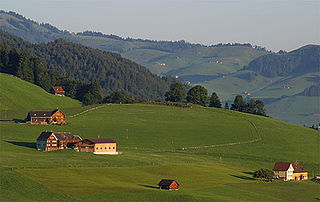
Sveti Lenart is a small settlement in the Municipality of Cerklje na Gorenjskem in the Upper Carniola region of Slovenia.

Sveti Florijan nad Škofjo Loko is a small settlement in the Municipality of Škofja Loka in the Upper Carniola region of Slovenia. The church of Saint Florian on a hill above the village, though actually belonging to the neighbouring village of Sopotnica, gave its name to the settlement.

Sveti Lenart is a village in the Municipality of Škofja Loka in the Upper Carniola region of Slovenia.

Sveti Ožbolt is a settlement in the Municipality of Škofja Loka in the Upper Carniola region of Slovenia.

Sveti Andrej is a settlement in the Municipality of Škofja Loka in the Upper Carniola region of Slovenia.

Sveti Tomaž is a small settlement in the Municipality of Škofja Loka in the Upper Carniola region of Slovenia.

Črna pri Kamniku is a village in the Municipality of Kamnik in the Upper Carniola region of Slovenia.

Sveti Vid is a small village in the hills northeast of Begunje in the Municipality of Cerknica in the Inner Carniola region of Slovenia.

Sv. Jernej nad Muto is a dispersed settlement in the hills north of Muta in the historical Styria region in northern Slovenia, right on the border with Austria. It also includes the former village of Bistriški Jarek, which was incorporated into the settlement in 1953.

Primož pri Ljubnem is a dispersed settlement in the hills north of Ljubno ob Savinji in Slovenia. Traditionally the area belonged to the region of Styria and is now included in the Savinja Statistical Region.

Vidovica is a settlement in the Municipality of Podčetrtek in eastern Slovenia, close to the border with Croatia. The area was traditionally part of the Styria region. It is now included in the Savinja Statistical Region.

Gore is a settlement in the Municipality of Hrastnik in central Slovenia. Traditionally the area was part of the Styria region. It is now included with the rest of the municipality in the Central Sava Statistical Region.

Tomaž nad Vojnikom is a settlement in the Municipality of Vojnik in eastern Slovenia. It lies in the hills east of Vojnik. The area was traditionally part of the Styria region. It is now included with the rest of the municipality in the Savinja Statistical Region.

Jelovice is a settlement in the western Haloze Hills in the Municipality of Majšperk in northeastern Slovenia. The area is part of the traditional region of Styria. It is now included with the rest of the municipality in the Drava Statistical Region.

Sveti Štefan is a small settlement in the Municipality of Šmarje pri Jelšah in eastern Slovenia. It lies in the hills south of Šmarje in the Kozje region. The area is part of the traditional region of Styria. The municipality is now included in the Savinja Statistical Region.

Podgaj is a small settlement south of Ponikva in the Municipality of Šentjur in eastern Slovenia. Traditionally the area is part of Styria. The municipality is now included in the Savinja Statistical Region.

Primož pri Šentjurju is a settlement in the Municipality of Šentjur in eastern Slovenia. The area is part of the historical Styria region. The municipality is now included in the Savinja Statistical Region. The settlement includes the hamlets of Bozne, Brezne, Grabne, and Kote.

Sveti Vrh is a settlement in the hills east of Mokronog in the Municipality of Mokronog-Trebelno in southeastern Slovenia. The area is part of the historical region of Lower Carniola. The municipality is now included in the Southeast Slovenia Statistical Region.

Šent Jurij is a village in the Municipality of Grosuplje in central Slovenia. The area is part of the historical region of Lower Carniola. The municipality is now included in the Central Slovenia Statistical Region.

Primož is a small village in the hills south of Boštanj in the Municipality of Sevnica in central Slovenia. The area is part of the historical region of Lower Carniola. The municipality is now included in the Lower Sava Statistical Region.
















